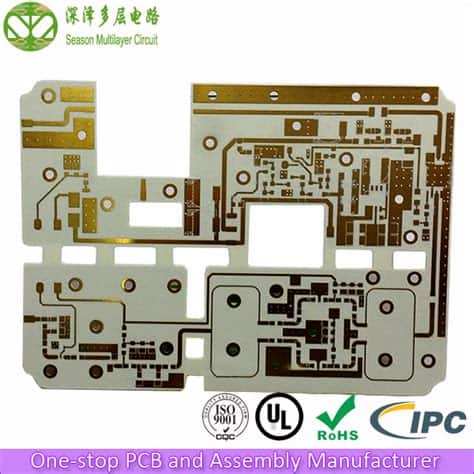What is Rogers PCB?
Rogers PCB refers to printed circuit boards that are manufactured using Rogers materials. Rogers Corporation is a leading manufacturer of high-performance printed circuit board materials, known for their excellent electrical, mechanical, and thermal properties. These materials are widely used in various industries, including telecommunications, aerospace, defense, and automotive, where high-frequency, high-speed, and high-reliability applications are essential.
Key Characteristics of Rogers PCB Materials
Rogers PCB materials exhibit several key characteristics that make them suitable for demanding applications:
-
Low Dielectric Constant (Dk): Rogers materials have a low dielectric constant, which helps to minimize signal loss and maintain Signal integrity at high frequencies.
-
Low Dissipation Factor (Df): The low dissipation factor of Rogers materials reduces power loss and heat generation, ensuring efficient signal transmission.
-
High Thermal Conductivity: Many Rogers materials have high thermal conductivity, which helps to dissipate heat effectively and prevent thermal damage to the PCB.
-
Dimensional Stability: Rogers materials maintain their dimensions and properties over a wide range of temperatures, ensuring consistent performance in various operating conditions.
-
Excellent Mechanical Properties: Rogers PCBs offer high strength, durability, and resistance to vibration and impact, making them suitable for demanding environments.
Popular Rogers PCB Materials
Rogers Corporation offers a wide range of PCB materials, each with unique properties tailored to specific applications. Some of the most popular Rogers PCB materials include:
1. RO4000 Series
The RO4000 series is a popular choice for high-frequency applications, such as wireless communication systems, radar, and satellite communications. These materials offer a low dielectric constant and dissipation factor, as well as excellent dimensional stability.
| Material | Dielectric Constant (Dk) | Dissipation Factor (Df) | Thermal Conductivity (W/m·K) |
|---|---|---|---|
| RO4003C | 3.38 ± 0.05 | 0.0027 @ 10 GHz | 0.71 |
| RO4350B | 3.48 ± 0.05 | 0.0037 @ 10 GHz | 0.69 |
| RO4360G2 | 6.15 ± 0.15 | 0.0038 @ 10 GHz | 0.66 |
2. RT/duroid Series
The RT/duroid series is known for its excellent high-frequency performance and low loss, making it suitable for applications such as microwave and millimeter-wave circuits, aerospace, and defense systems.
| Material | Dielectric Constant (Dk) | Dissipation Factor (Df) | Thermal Conductivity (W/m·K) |
|---|---|---|---|
| RT/duroid 5870 | 2.33 ± 0.02 | 0.0012 @ 10 GHz | 0.22 |
| RT/duroid 5880 | 2.20 ± 0.02 | 0.0009 @ 10 GHz | 0.20 |
| RT/duroid 6002 | 2.94 ± 0.04 | 0.0012 @ 10 GHz | 0.60 |
3. TMM Series
The TMM (Thermoset Microwave Materials) series is designed for high-frequency, low-loss applications that require a stable dielectric constant over a wide temperature range. These materials are well-suited for automotive radar, aerospace, and defense applications.
| Material | Dielectric Constant (Dk) | Dissipation Factor (Df) | Thermal Conductivity (W/m·K) |
|---|---|---|---|
| TMM3 | 3.27 ± 0.032 | 0.0020 @ 10 GHz | 0.70 |
| TMM4 | 4.50 ± 0.045 | 0.0020 @ 10 GHz | 0.70 |
| TMM6 | 6.00 ± 0.080 | 0.0023 @ 10 GHz | 0.70 |

Advantages of Rogers PCB by RAYPCB
RAYPCB is a leading PCB manufacturer that specializes in fabricating high-quality Rogers PCBs. By choosing RAYPCB for your Rogers PCB needs, you can enjoy several advantages:
-
Expertise and Experience: RAYPCB has extensive experience in manufacturing Rogers PCBs and a deep understanding of Rogers materials and their applications. This expertise ensures that your PCBs are fabricated to the highest standards.
-
State-of-the-Art Facilities: RAYPCB invests in advanced manufacturing equipment and facilities to produce Rogers PCBs with tight tolerances, high precision, and consistent quality.
-
Strict Quality Control: RAYPCB implements strict quality control measures throughout the manufacturing process, from material selection to final inspection, to ensure that every Rogers PCB meets or exceeds customer requirements.
-
Quick Turnaround Times: With streamlined processes and efficient production lines, RAYPCB can deliver Rogers PCBs with quick turnaround times, helping you meet your project deadlines.
-
Customization Options: RAYPCB offers a wide range of customization options for Rogers PCBs, including layer count, thickness, copper weight, surface finish, and more. This flexibility allows you to tailor the PCB to your specific application requirements.

Applications of Rogers PCB
Rogers PCBs find applications in various industries and products, including:
-
Telecommunications: Rogers materials are extensively used in wireless communication systems, such as 5G networks, base stations, and antennas, due to their excellent high-frequency performance and low loss.
-
Aerospace and Defense: The high reliability, dimensional stability, and resistance to harsh environments make Rogers PCBs suitable for aerospace and defense applications, such as radar systems, satellite communications, and avionics.
-
Automotive: With the increasing adoption of advanced driver assistance systems (ADAS) and autonomous vehicles, Rogers PCBs are used in automotive radar systems, vehicle-to-vehicle communication, and other high-frequency applications.
-
Medical Devices: Rogers materials are used in medical devices that require high-frequency performance, such as MRI systems, ultrasound equipment, and wireless medical monitoring devices.
-
Industrial and Scientific Instruments: Rogers PCBs are used in various industrial and scientific instruments that operate at high frequencies, such as test and measurement equipment, RF and microwave components, and sensors.

Designing with Rogers PCB Materials
When designing PCBs using Rogers materials, there are several considerations to keep in mind:
-
Material Selection: Choose the appropriate Rogers material based on your application requirements, such as dielectric constant, dissipation factor, thermal conductivity, and mechanical properties.
-
Impedance Control: Ensure proper impedance control by carefully designing the trace widths, spacing, and layer stack-up. Rogers materials’ dielectric constants and thicknesses play a crucial role in achieving the desired impedance.
-
Thermal Management: Consider the thermal properties of the Rogers material and design the PCB Layout to minimize heat generation and ensure efficient heat dissipation. This may involve using thermal vias, heat spreaders, or other thermal management techniques.
-
Manufacturing Considerations: Work closely with your PCB manufacturer, such as RAYPCB, to ensure that the design is compatible with their manufacturing capabilities and guidelines. This includes specifying the appropriate layer count, copper weight, surface finish, and other fabrication parameters.
-
Testing and Validation: Perform thorough testing and validation of the Rogers PCB design to ensure that it meets the desired performance, reliability, and functionality requirements. This may involve high-frequency testing, thermal cycling, and other application-specific tests.
Frequently Asked Questions (FAQ)
- What are the main advantages of using Rogers PCB materials?
-
Rogers PCB materials offer several advantages, including low dielectric constant, low dissipation factor, high thermal conductivity, dimensional stability, and excellent mechanical properties. These properties make Rogers PCBs suitable for high-frequency, high-speed, and high-reliability applications.
-
How do I select the right Rogers material for my application?
-
When selecting a Rogers material, consider your application requirements, such as the operating frequency, signal loss tolerance, thermal management needs, and mechanical requirements. Consult the material datasheets and work with your PCB manufacturer to choose the most suitable Rogers material for your specific application.
-
Can Rogers PCBs be manufactured with multiple layers?
-
Yes, Rogers PCBs can be manufactured with multiple layers, depending on the specific material and the PCB manufacturer’s capabilities. RAYPCB, for example, can fabricate multi-layer Rogers PCBs with precise layer alignment and controlled impedance.
-
What surface finishes are available for Rogers PCBs?
-
Rogers PCBs can be manufactured with various surface finishes, including Hot Air Solder Leveling (HASL), Immersion Silver (ImAg), Immersion Tin (ImSn), and Electroless Nickel Immersion Gold (ENIG). The choice of surface finish depends on the application requirements, such as solderability, durability, and high-frequency performance.
-
How do I ensure the reliability of my Rogers PCB design?
- To ensure the reliability of your Rogers PCB design, follow best design practices, such as proper impedance control, thermal management, and manufacturing considerations. Work closely with your PCB manufacturer, like RAYPCB, to validate your design and perform rigorous testing to verify the PCB’s performance and reliability under the expected operating conditions.
Conclusion
Rogers PCBs are an excellent choice for applications that demand high performance, reliability, and stability in challenging environments. With their superior electrical, mechanical, and thermal properties, Rogers materials enable the design and manufacture of PCBs that can withstand the rigors of high-frequency, high-speed, and harsh operating conditions.
By partnering with a reputable PCB manufacturer like RAYPCB, you can leverage their expertise and state-of-the-art facilities to create custom Rogers PCBs that meet your specific application requirements. From material selection and design optimization to fabrication and testing, RAYPCB provides end-to-end solutions for your Rogers PCB needs.
As technology continues to advance and the demand for high-performance electronic systems grows, Rogers PCBs will play an increasingly crucial role in enabling innovation across various industries, from telecommunications and automotive to aerospace and medical devices. By staying at the forefront of Rogers material technology and PCB manufacturing capabilities, companies like RAYPCB are well-positioned to support the evolving needs of their customers and help them bring cutting-edge products to market.

No responses yet